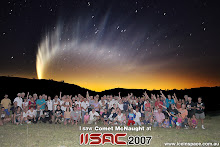
It is important to remember that there are many different styles of art throughout Australia. In pre-European times Aborigines painted on caves, bark, on sand and on their bodies. In additions to this the walls of our huts (the building of permant/semi-permanent dwellings was much more wide spread than commonly known) were decorated with art work, as were the possum skin fur coats some tribes wore. Implements for both play & work eg. didgeridoos & boomerangs were also decorated with art. It has been said that Aborigines devoted more time to art than any other race. Orche colours were the most common as they were available in most places. However other colours (even blue) were occasionally used, if there was an available source of that colour.
Art was often used to tell a story and for educational purposes. A painting that comes with a detailed story can be a good investment piece. Does the story match the "dreamings" of the area the artist is said to come from? Or is the painting for tourists? (Paintings from outback areas can be more 'fake' in this regard than urban Aboriginal art.) Educate yourself about the art that belongs to different areas of Australia. Even within areas, what are the tribal symbols? Are there any totems clans should or should not use? Does the subject of the painting match the sex of the artist? eg.a female should never include a didgeridoo in a paintings. In many (though probably not all) areas of Australia only female artists paint wombats and numbats. Women are also gatherers so often show more details of plants in their paintings. Men tend to have more landscape forms in paintings because hunting often occurs over a large area. Does the painting conform to what you have been able to learn about "genuine" works from that area? There are plenty of good reference books in libraries that will guide you. One tip you probably have never heard before is to examine "cave art" from the area of the artist. Cave Art is always an example of the authentic style of that area. The range of Native Australian Art is much wider than most people think. Dot Art is only one style; and is not as wide spread as is often thought. Though the Desert Artists are popular, Aboriginal Art from other areas is just getting to be better known, and could make an excellent investment piece. Genuine paintings are always painted from a certain angle; even landscapes by Aboriginal artists conform to this principle, which gives them their unique look. In this latter case, watch out for Aboriginal artists who make a point of proclaiming their university training. Most paint genuine art, but I have come across ones who seem to have lost the very basis. Fairer skinned Aboriginals are often expert traditional artists & many produce paintings worth $1,000s. Likewise a darkskinned person holding a painting doesn't mean that the painting is any good as an investement piece & doesn't even prove 100% that they are even the artist!
Look at the painting above Rosetta Dreaming. The artist comes from an area where Eastern Rosellas occur & she has used the traditional symbols to tell the lifecycle & story of the birds. She has used double dot work to show the brillant colours of the rosella. They are depicted nesting in hollow trees, eating grass seed & flying. She has used white dots to signify dreaming as they traditionally mean & has even given the painting a bit of a featherly look. Rosella Dreaming is a modern traditional paintings that expresses our culture well. More details of this painting are at http://www.aboriginalarttreasures.com/paintings.php
